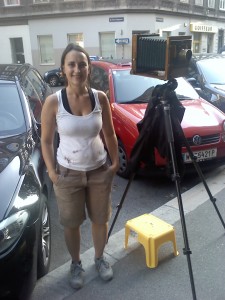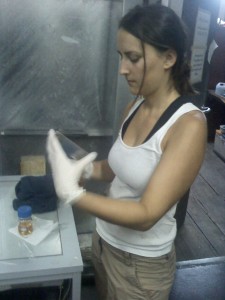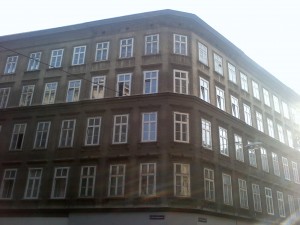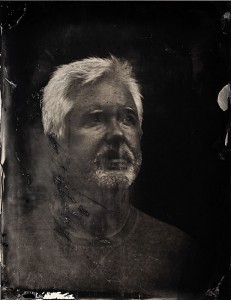Man 1: Apparently, to be considered a down to earth politician in Vienna, you have to be overweight and look half-drunk.
Man 2: So you mean I could go into politics?
Man 1: Your hair’s too long.
Tag Archives: vienna
Viennese politics
Deprivation, isolation, floating
What say the slain?
One day, months ago, during a brief respite from political ranting during a drive into town with Gamma, we listened to a radio program about a sensory deprivation / isolation / floating tank business in Vienna.
“I’ve always wanted to try that,” I said.
Gamma filed that information away neatly and guess what my daughters gave me for Father’s Day?
This is how I found myself sitting on a shady bench in a Vienna cemetery yesterday evening. I was early for my appointment at the Sargfabrik, an apartment complex in Vienna with a theater instead of a parking garage, and down in the cellar a room with a floatation tank.
Floatation (or floating? not sure) tank is what used to be called an isolation tank, and before that sensory deprivation tank.
I prefer sensory deprivation tank, but understand one must market the things.
Like I was saying, I was early as always and took a walk around the neighborhood and disliked the park (too sunny, for one thing, and generally unlikeable, at least yesterday evening, for me, at that spot) so I continued onward and found the cemetery next door and went in and found a shady bench and watched the gravediggers work, and read the dates on the headstones, as one does.
Then I thought, Ah! Cemetery – Sargfabrik, I get it!
I guess the Sargfabrik used to be an actual coffin factory until it was converted into housing.
Then I texted the floating tank guy that I was already in the neighborhood, in case I could get in early, and I did and there I sat, no longer in the cemetery, in the cellar, in a dimly lit, cool room, being orientated.
Epilepsy? he said. Claustrophobia?
Nah, I said.
Goals? Hopes? he said.
Curiosity, I said. Father’s Day.
He looked a little disappointed, (but I might have been making that up, there in the dim light) so I added, maybe get an insight into this deep sadness I lug around all the time that is kinda the mortar holding my world together? Or into this yapping I have been doing with my wife?
Okay, he said. I dunno, he didn’t look real relieved so maybe it really was the dim light after all.
He said he’d knock on the outside of the tank when my time was up, and left.
I took a shower and got into the tank and shut the lid.
I spent a long time getting comfortable which is weird because what could be more comfortable than floating naked in a shallow tub of super dense saltwater in the dark?
But such is life.
I floated there in the dark listening to something hum. Something was fucking humming! What kind of sensory deprivation is this? Maybe it was the ventilation.
More of a buzz than a hum. And not loud, but still.
It wasn’t me.
Then either I got used to it or it stopped.
I listened to my breathing for a while, and to my heartbeat.
After a long, tiring day, I was surprised I did not fall asleep, or even get sleepy. After lunch I had been nodding off at my desk.
I sort of meditated for a while. I hummed a little. My mind was pretty blank a lot of the time.
At some point I woke up, or regained consciousness, or something. So I was out for a while, in one way or another.
Toward the end, trying out different ways of holding my head and comparing relative comfort, I got salt water in both eyes and was really glad the orientator had showed me where the kleenexes were in case that happened. I opened the hatch and wiped out my eyes and closed the lid again and eventually the stinging stopped.
One’s ears are submerged in the tank, so sounds are muffled.
I lay there listening to my heartbeat.
Thump-thump-thump! Then after three thumps it stopped again. Weird, I thought. I tried various positions to hear my heartbeat clearly again like that. Then I did, I heard it again. Thump-thump-thump.
After doing this a few more times I realized it was the guy knocking on the outside of the tank that my time was up.
He went away again and I lay there for a minute, thinking, Well that was an anticlimax.
No jumping out of the tank and running around like a caveman like William Hurt in Altered States. No hallucinations, no epiphanies.
It didn’t even seem all that different from my normal, daily life, I thought.
Then I thought, my normal, daily life is like an isolation tank.
Then I thought, there’s an epiphany for you after all.
Posted in Das Gehirn, Familie, ferner liefen, Metamorphosism
Tags: beta, epiphany, Father's Day, floatation, gamma, isolation, sargfabrik, self-knowledge, sensory deprivation, tank, vienna
On manners at the opera
My wife and I went to see Madame Butterfly at the Vienna State Opera on the weekend. We had pretty good seats. We got some champagne beforehand, as we usually do at the opera, except she was more in the mood for a white wine spritzer and had that, and I had a whiskey (no brand given) because I was feeling macho.
The people behind us were loud, rude, stupid and very excited about the cruise they were booked on, apparently, because they could not STFU about it. One encounters such people at most public performances, including the movies, but this was a first for me at the opera.
Srsly, WTH?
They must have gotten free tickets from someone.
The lights went down, the warning to turn off your phone played, etc etc and still they jabbered on. I knew I had to do something.
The musicians finished tuning. The conductor came out, to warm applause.
Yeah, yeah, Cruise This and Cruise That!
Peace settled over my mind as I made a decision. I felt like a Jason Statham character right before a big action scene, you know, like, where he’s surrounded by all these bruisers in an auto mechanic’s garage — except I was surrounded by old people with canes, and younger people, and improperly-dressed tourists. Even the standing area way up at the top was full.
They were still talking — unbelieveable — when the music started playing, and they showed no intention of stopping. That’s when – right after the first note – I turned and said it:
“Ssh!”
Boy, did that do it. They didn’t say a peep until intermission. Sometimes you just have to take a stand.
We went outside in the intermission. On the way there, I found a big, fat pearl earring and gave it to an usher. If you’re looking for your pearl earring, it’s probably in a pawn shop in downtown Vienna by now.
We did not stay outside for long, because it turns out that’s where everyone goes to smoke.
So the air was better back inside. Good people watching night.
Great performance, too. Downer though, sheesh.
Posted in Das Cello, Das Gehirn, ferner liefen, Metamorphosism
Tags: madame butterfly, puccini, rudeness, ssh, staatsoper, vienna
Adventures in collodion wet-plate photography
This is Agnes Prammer with her collodion wet-plate camera.
It started this summer. I read an ad online looking for models. Men over 60 with beards, and pregnant women.
I thought that sounded like an interesting combination, and in my optimism (I met 2 of the 5 requirements, being a man with a beard) contacted the photographer.
And that is how I found myself…
…wait, I also wanted to insert somewhere towards the start, ‘earlier that summer my family and I were wandering around Vienna late at night and looked inside this one large building full of… stuff, and pillars, and mysterious light, and I thought at the time how full of surprises and interesting architecture Vienna is and what kind of life must that be that has one frequenting such buildings?’
Done.
So I contacted the photographer and she said sure, she’d take my picture for her project, and I programmed the address into my GPS and drove there.
The first interesting detail in this interesting story is the fact that the address does not exist. The proper address is number 6, and the GPS took me to the right place, but the number over the door is an 8. Mysterious, right? Also it turned out to be the mysterious building we had seen earlier in the summer, the studios of the academy of fine arts.
Luckily the photographer was waiting for me outside, which is proper etiquette when your address is imaginary.
The photographer’s name is Agnes Prammer. She does collodion wet-plate photography, which to my understanding is the (American) Civil War-era process that produces negative images onto glass or metal plates using a liquid emulsion. Tin type photos are one example of this, I guess. Agnes became interested in collodion wet-plate photography while in the United States, where the technology has been revived (or popularized) by Civil War re-enactors, among other people.
She explained her project to me, I changed into a sweater she wanted me to wear for the photo, and she took me to her studio, which was a stool on the sidewalk outside the academy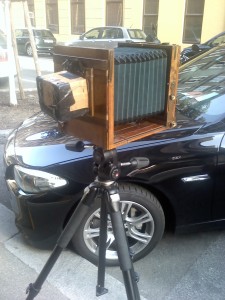 , with a black backdrop. Wet-plate photography requires long exposure times so usually is done outside in natural light.
, with a black backdrop. Wet-plate photography requires long exposure times so usually is done outside in natural light.
Agnes uses an antique camera. I thought it would be neat to take pictures of her for this blog post with my daughter’s Polaroid camera for double retro-technology points, but I couldn’t get the Polaroid to work ( you have to push the button repeatedly, it turns out) so I took these photos here with my smartphone, which gets irony points instead.
Agnes’ camera is the real deal – you sit there in the sun trying not to perspire in a borrowed sweater while she (under the black sheet, to keep the light out so she can see the image) focuses on a frosted glass plate in the camera. Then she goes into the darkroom, puts emulsion onto a metal plate (like most wetplate photographers, she gets her aluminum plates from a trophy supplies company in the United States) (some use glass plates, but they are fussier and of course fragile) which takes about 5 or ten minutes, then carries it back to the camera in a plate holder. The plate holder trades places with the frosted glass focus thing and the camera is ready to go.
The camera is very simple, and has no shutter. There is a lens cover (Agnes uses a cardboard box) which is removed to take the picture and put back to stop the exposure. That day, in the bright sun, Agnes used an exposure time of 10-15 seconds. Then she took the plate holder back out of the camera, and ran back to her darkroom to develop it. That took about ten minutes.
In other words, it takes about twenty minutes per photo. The plate must be exposed and developed while wet, so it can be kind of a rush depending on temperature.
Agnes wasn’t really happy with the first picture so we did it again.
Wet-plate cameras are great ice breakers. While Agnes was back in her darkroom getting the next plate ready, everyone who walked past asked me about it.
I couldn’t tell them much, sorry.
Agnes doesn’t always use her darkroom. Like many wet-plate photographers, she has a portable field darkroom. I am kicking myself for not taking a picture of it, because it is awesome. She made it out of a baby carriage.
Agnes eventually came back out and got set up again. While she was getting set up, Roland Neuwirth walked past on the other side of the street. I am a big fan of his, but I ignored him because he is over sixty and has a bigger beard than I do, and I feared if Agnes noticed him she would kick me to the curb.
The second photo turned out better and we were done. Agnes gave me a tour of her darkroom and let me watch her develop the plate. This is how it works: collodion is a solution containing ether. It is poured over the plate to get an even film; when the ether evaporates, it leaves a tacky transparent film (it is also used in medicine to cover wounds). The plate is then placed in a silver nitrate bath. This is why Agnes is wearing gloves in the darkroom photo. Back in the day, wet-plate photographers were known by their black fingers. Then the plate is put into a plate holder, and exposed in the camera, and developed, all while still wet.
In a way, it is a form of instant photography, if you consider 10-20 minutes instant. And in fact, it still survives (more or less, in a relatively similar form, anyway) as instant street photography in the Afghan box camera (AKA kamra-e-faoree) in Afghanistan.
What I am not sure of is whether wet plate photography is resurging, thanks to Civil War re-enactors and antique technology buffs, or if it only seems that way to me because I am googling it and finding tons of information and projects. Maybe it was there all along.
Here is a Wired article on John Coffer, who has been doing wet plate photography for years now. He eschews the automobile and travels by horse, and lives in a house with no electricity or running water. Here is his website.
The technology is interesting because it is so simple. There is no shutter – it is basically a camera obscura, as my daughter Gamma says. If you can get a lens, you could theoretically make one yourself. Ian Ruhter made one out of a van to make impressive large-format tin types. You make each plate yourself, with chemicals that will get you high (ether) or kill you (some techniques use cyanide). This is another reason it is a good outdoor activity. At the same time, the results are superior to modern film photography, because (Agnes tells me) there is no grain because it is a liquid emulsion.
There will be a workshop next spring and I can’t wait to go.
Posted in ferner liefen, Metamorphosism
Tags: agnes prammer, art, collodion, photography, reportage, vienna, wetplate
Hello, green grasshopper
We had a big green grasshopper in the living room a couple nights ago. Naturally it kept jumping on Gamma, who currently has what I imagine is a temporary case of acridophobia, the fear of having big green grasshoppers jumping on you. I caught him with a dish and a newspaper (directions: while grasshopper is distracted reading the paper, put the dish over him) and put him into the hanging basket outside.
The following day, I was going to the kids’ apartment in Vienna after work to pick up Gamma to give her a ride home when I noticed a green grasshopper on the dashboard. It was a different one, I think. It looked smaller.
Hello, green grasshopper, I said.
I hoped it wouldn’t jump into my face while I drove and cause an accident.
I decided I would catch it when I got to the apartment and put it in a plant.
But it was so quiet I forgot it was there. Also I distracted myself thinking about how, in the 1980s, my first decade of adulthood, I thought everyone was crazy who bought the idea that deregulating anything was a good idea and how the past 30 years have proven me right and regulations were put in place for a reason and why not just take mean dogs off their leashes and take off their muzzles and say, go for it, dogs? Time to put a little more trickle in the trickle down.
So my mind was not on grasshoppers when I got where I was going.
Also I was thinking about how blogging is dead, personal blogging like this, I mean, now that everyone is on facebook, only you can’t write the way I write here on facebook, at least I can’t.
I got Gamma and we were driving along and something green flew past and Gamma was all, eek! And I was all, what? And she was all, IT’S ON YOU! and I was all, what? And she was all, green! Green grasshopper! And I was all, oh, right.
It was on my shoulder so I rolled down the window and threw it out (we were at a light) and it flew into some trees.
In the direction of the trees, at least. Up, for example.
Little green grasshopper.
Posted in Das Gehirn, Familie, Metamorphosism
Tags: apartment, blogging, deregulation, driving, economics, gamma, grasshopper, vienna
